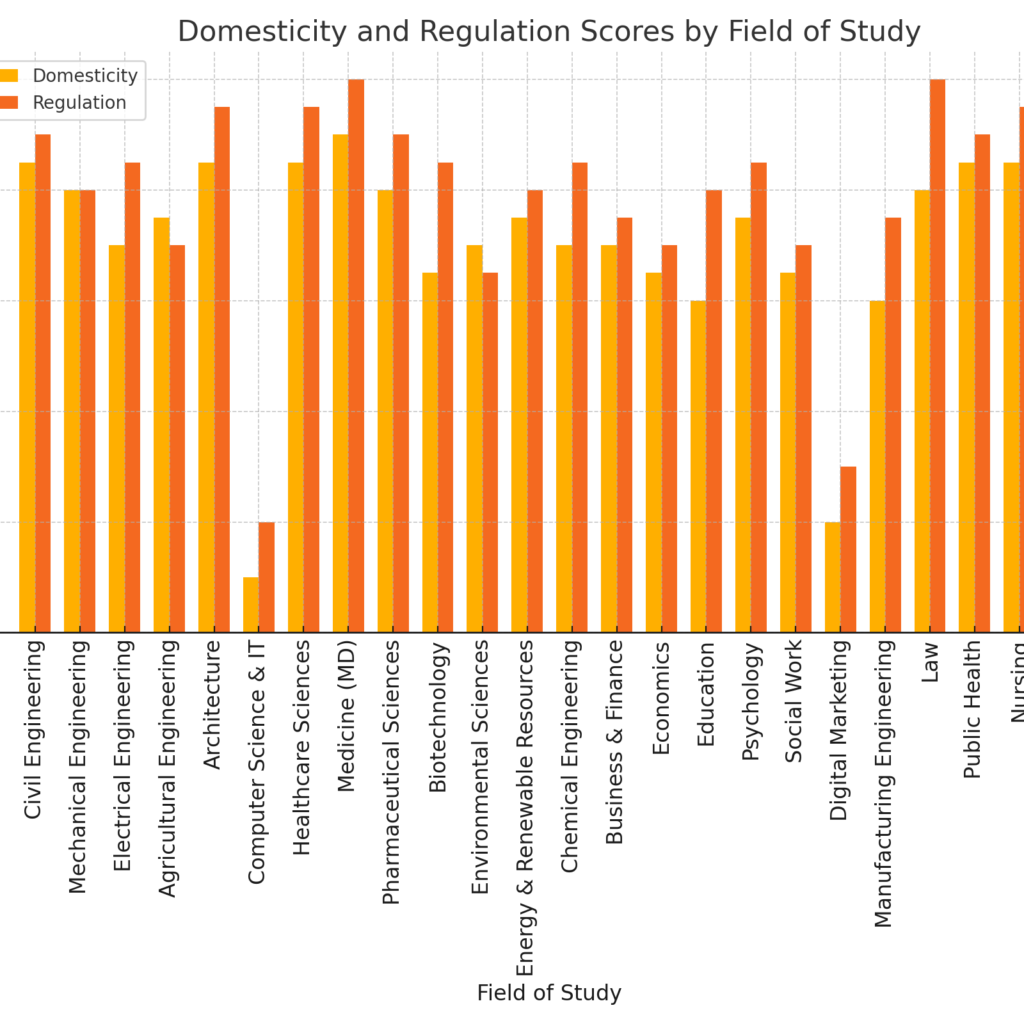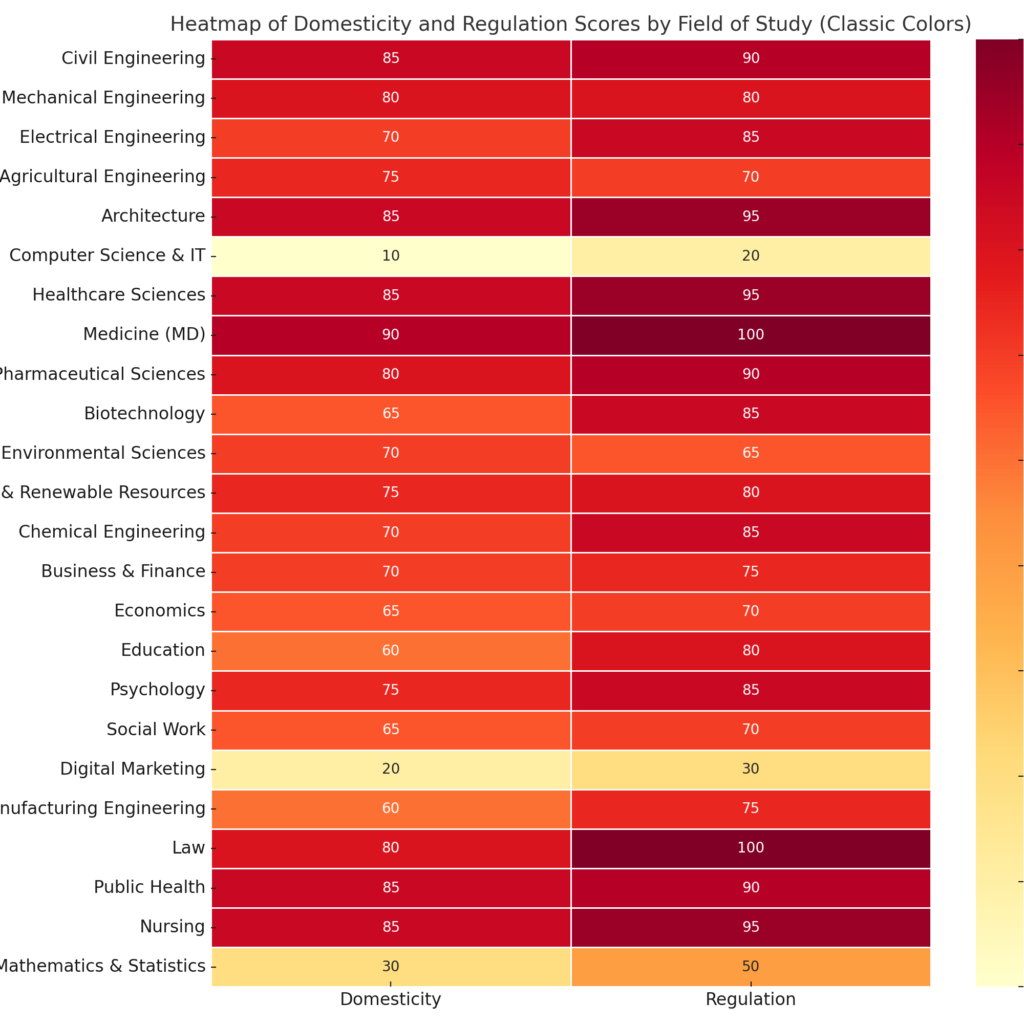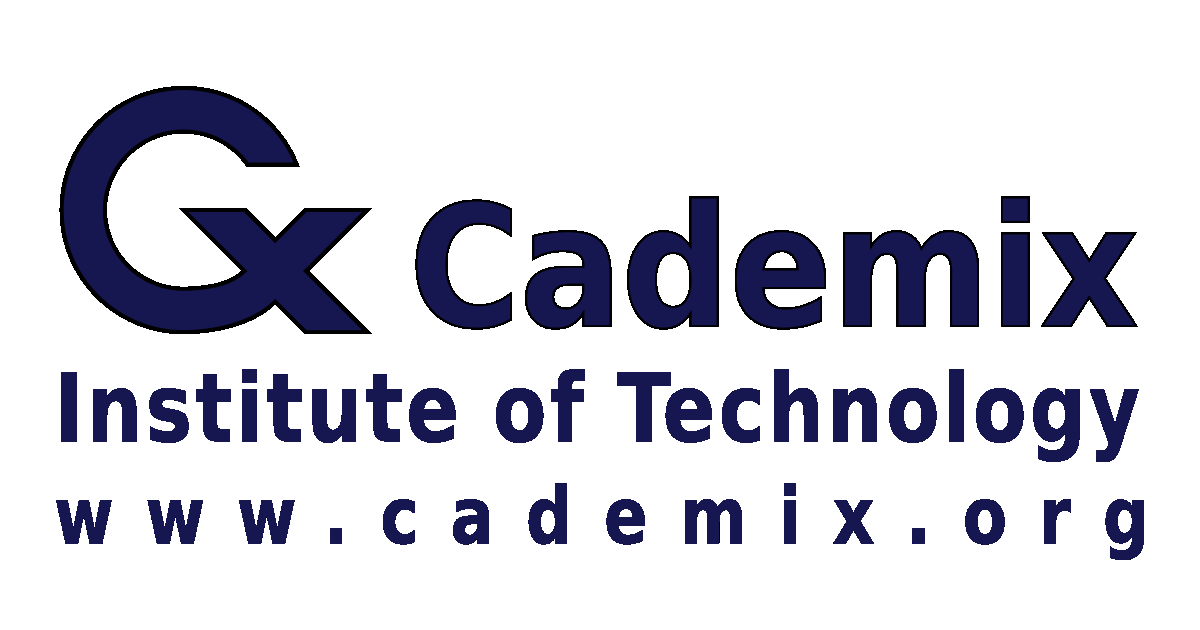Europe’s job market is both competitive and diverse, attracting skilled professionals from around the world who seek robust career growth, work-life balance, and high-quality living standards. However, navigating the European job market is challenging, particularly due to the differences in domesticity and regulation across professions. Each profession in Europe may require varying degrees of local knowledge, professional licensing, and qualifications, impacting how accessible certain roles are for international job seekers.
In this article, we quantify domesticity and regulation for high-demand fields across Europe, from engineering and healthcare to IT and finance. We examine each field’s requirements through data provided by Eurostat, EURES, and OECD labor reports, and visualize these scores in bar charts and heatmaps to guide international job seekers, European employers, and policymakers.
Keywords: European job market, professional migration to Europe, job demand in Europe, professional qualifications in Europe, high-demand job sectors, engineering in Europe, healthcare in Europe, information technology in Europe, renewable energy, local employment standards, domesticity in job sectors, regulatory challenges in migration, impact of regulation on migration, skill gaps in Europe, job opportunities for migrants, professional integration in Europe, work permits in Europe, migration trends in high-demand fields.

Two primary concepts play a crucial role in understanding this accessibility:
Domesticity: This measure indicates the degree to which a profession is shaped by local standards, cultural norms, and country-specific practices. It highlights the necessity for professionals to adapt to the unique context in which they operate within a specific country or region. For example, fields such as civil engineering and architecture tend to score highly on the domesticity scale, reflecting their reliance on local building codes, urban planning regulations, and aesthetic preferences. Civil engineers must understand the intricacies of infrastructure development, including zoning laws, environmental guidelines, and safety standards that vary significantly across countries. Similarly, architects are required to be sensitive to local design sensibilities and cultural influences that dictate how spaces are constructed and utilized.
On the domesticity scale, scores range from 0 to 100. A score of 0 indicates a profession that is largely transferrable across borders, with minimal reliance on local context. For instance, roles in software development or digital marketing can often be performed from anywhere, as they are not heavily tied to specific local practices. In contrast, a score of 100 signifies a profession that is entirely local in its requirements, necessitating comprehensive knowledge of the local regulatory framework and cultural expectations. Such a high domesticity score means that professionals in these fields must often undergo specific training or certification processes within the country to ensure compliance with local standards.
Regulation: Regulation measures the extent of formal qualifications, certifications, or licenses required to practice in a given field. Professions with high regulation are typically governed by stringent local rules that mandate specific criteria for legal practice. For example, healthcare and legal professions are heavily regulated; healthcare workers must obtain relevant medical licenses and adhere to strict ethical and operational guidelines, while legal practitioners must pass bar examinations and fulfill other regulatory requirements to be licensed to practice.
Regulation scores also range from 0 to 100. A score of 0 indicates a profession with low or minimal regulatory barriers, suggesting that individuals can enter the field with relatively few formal qualifications. An example of this might be freelance graphic design, where a strong portfolio is often more important than formal certifications. Conversely, a score of 100 denotes very high levels of regulation, where practitioners face rigorous scrutiny and must fulfill extensive educational and experiential requirements to be licensed or certified in their profession.
Note: By applying the 0-100 scale to domesticity and regulation, we aim to provide embodiment and objectivity to the subject, enhancing understanding for readers. This approach also offers valuable insights into the challenges and opportunities that professionals face when migrating to new countries. Understanding how a profession is influenced by these factors enables skilled workers to better position themselves for success in Europe’s dynamic job market, allowing them to adapt their qualifications and expectations to meet local standards and regulatory demands.
Exploring Engineering Fields: Localized Knowledge and High Regulatory Barriers
Civil Engineering: Civil engineers play a foundational role in developing Europe’s infrastructure, adhering to strict standards for construction, safety, and environmental sustainability. With domesticity scored at 85 and regulation at 90, civil engineering requires local licensing and familiarity with each country’s building codes. Membership in local engineering associations and validation of degrees are common requirements for civil engineers.
Mechanical Engineering: As a versatile field covering automotive, industrial machinery, and aerospace sectors, mechanical engineering’s domesticity sits at 80, with a regulation score of 80. Professionals often need to understand European safety standards and may require certifications from bodies like the European Network for Accreditation of Engineering Education.
Electrical Engineering: Electrical engineering is integral to Europe’s energy, communications, and industrial sectors, making compliance with EU energy standards crucial. With domesticity at 70 and regulation at 85, the field requires familiarity with local electricity distribution protocols and safety regulations. Electrical engineers often join European electrical engineering councils and may need licenses for high-voltage systems work.
Agricultural Engineering: European agriculture emphasizes sustainable practices, with professionals managing water resources, soil conservation, and crop efficiency. Agricultural engineers have a domesticity score of 75 and regulation score of 70, due to the need to adapt to local agricultural policies. Many roles also involve work with environmental regulations, adding to the field’s regulatory demands.
Architecture: Architecture in Europe is highly domestic, with a score of 85 for domesticity and 95 for regulation, as architects must comply with local zoning laws, cultural preservation codes, and safety standards. Architects are required to pass local exams, acquire membership in national councils, and participate in continuous professional development to maintain licensure.

Healthcare and Medical Fields: Meeting Stringent Requirements
Healthcare Sciences: Nursing and other allied health professions in Europe require high compliance with local health regulations. With domesticity at 85 and regulation at 95, healthcare professionals must often validate foreign degrees, complete local exams, and demonstrate language proficiency.
Medicine (MD): Physicians are subject to some of the highest regulatory standards, with domesticity at 90 and regulation at 100. Medical professionals must pass national exams and be fluent in the local language to practice legally. Local certification bodies rigorously evaluate medical degrees, often requiring residency training in Europe.
Pharmaceutical Sciences: Pharmaceutical professionals adhere to strict standards for drug safety, efficacy, and public health. With domesticity at 80 and regulation at 90, roles like pharmacists and clinical research scientists require licensure through national regulatory agencies, and many countries mandate ongoing education for re-certification.
Public Health: Public health professionals handle disease prevention, epidemiology, and policy advocacy. With domesticity and regulation scores of 85 and 90, respectively, they often need specific degrees accredited by local health ministries. Public health experts work within country-specific healthcare frameworks to address unique population health needs.
IT and Computer Science: High Demand with Low Regulatory Barriers
Information technology roles are among the most accessible fields in Europe for international professionals, largely because they require fewer local qualifications. Fields like Software Development and Data Science score 10 for domesticity and 20 for regulation, reflecting their global skill relevance. While proficiency in specific software and technologies is necessary, the lack of licensing requirements makes IT one of the least restrictive fields in the European job market.
How Domesticity and Regulation Impact Career Opportunities in Europe
For international job seekers aiming to work in Europe, the analysis of domesticity and regulation across various fields is invaluable. Engineering and healthcare professions have high domesticity and regulation scores, indicating that these roles require strong local knowledge, licensing, and often language proficiency. Meanwhile, fields like IT and digital marketing are much more accessible due to low domesticity and regulatory barriers, making them ideal entry points for international professionals seeking swift integration into the European workforce.
By understanding the domesticity and regulation requirements for high-demand professions in Europe, job seekers can make informed decisions about their education, certification, and career paths. Policymakers might consider adapting regulations to encourage talent in sectors with labor shortages, such as healthcare, renewable energy, and certain engineering disciplines.
| Field of Study | Specific Professions | Domesticity (0-100) | Regulation (0-100) |
|---|---|---|---|
| Civil Engineering | Civil Engineer, Urban Planner | 85 | 90 |
| Mechanical Engineering | Mechanical Engineer, Industrial Designer | 80 | 80 |
| Electrical Engineering | Electrical Engineer, Power Systems Engineer | 70 | 85 |
| Agricultural Engineering | Agricultural Engineer, Environmental Consultant | 75 | 70 |
| Architecture | Architect, Landscape Architect | 85 | 95 |
| Computer Science & IT | Software Developer, Data Scientist | 10 | 20 |
| Healthcare Sciences | Nurse, Radiology Technician | 85 | 95 |
| Medicine (MD) | General Practitioner, Specialist Physician | 90 | 100 |
| Pharmaceutical Sciences | Pharmacist, Clinical Research Scientist | 80 | 90 |
| Biotechnology | Biotechnologist, Biomedical Engineer | 65 | 85 |
| Environmental Sciences | Environmental Scientist, Ecologist | 70 | 65 |
| Energy & Renewable Resources | Renewable Energy Engineer, Environmental Policy Specialist | 75 | 80 |
| Chemical Engineering | Chemical Engineer, Process Engineer | 70 | 85 |
| Business & Finance | Financial Analyst, Accountant | 70 | 75 |
| Economics | Economist, Economic Analyst | 65 | 70 |
| Education | Teacher, Educational Administrator | 60 | 80 |
| Psychology | Clinical Psychologist, Research Psychologist | 75 | 85 |
| Social Work | Social Worker, Counselor | 65 | 70 |
| Digital Marketing | Digital Marketer, SEO Specialist | 20 | 30 |
| Manufacturing Engineering | Manufacturing Engineer, Quality Control Analyst | 60 | 75 |
| Law | Lawyer, Legal Consultant | 80 | 100 |
| Public Health | Public Health Specialist, Epidemiologist | 85 | 90 |
| Nursing | Registered Nurse, Nurse Practitioner | 85 | 95 |
| Mathematics & Statistics | Statistician, Data Analyst | 30 | 50 |


Review of Professional Migration Trends to Europe by Field of Study
In recent years, Europe has seen an influx of highly skilled professionals in response to a rising demand for expertise across various fields, particularly in engineering, healthcare, IT, and renewable energy. According to recent data from Eurostat and OECD migration reports, there has been an increase in the number of international professionals obtaining visas and certifications to work in Europe, particularly in fields critical to infrastructure, public health, technology, and environmental sustainability. This section provides a statistical overview of migration trends, illustrating the fields where migrant professionals have seen the highest integration rates across Europe.
For Reading More; Comprehensive Guide to the German Job Seeker Visa: How to Apply, Eligibility, and Tips for Success
Key Migration Trends by Field
Engineering Professions: Europe’s engineering fields continue to see a steady flow of skilled migrants, particularly in civil, mechanical, and electrical engineering. Countries like Germany, France, and the Netherlands are primary destinations, with Germany leading the demand due to its strong industrial and manufacturing base. According to Eurostat, civil engineering has a 10% annual migration increase, driven by demand for infrastructure development and sustainable urban planning projects. Mechanical and electrical engineers see similar trends, with top destinations including Germany, Sweden, and Norway. These roles typically require EU-recognized engineering licenses and proficiency in local languages for site-based roles.
Healthcare and Medical Professions: Europe’s healthcare sector has experienced one of the largest increases in migrant professionals, particularly in the UK, Germany, and Sweden. For fields like nursing and radiology in healthcare sciences, migration rates have increased by 12% annually, with migrant nurses and radiologists addressing personnel shortages. Meanwhile, medical doctors (MDs) are in exceptionally high demand, with migration rates reaching 15% per year. MDs seeking to work in Europe face strict requirements, including licensing exams and, in some cases, residency training within the host country.
Information Technology (IT): IT and computer science continue to dominate Europe’s migration trends, with annual growth in migration rates at 18%, the highest among all fields. Ireland, Estonia, and Germany have been particularly receptive to software developers, data scientists, and cybersecurity experts. The IT field’s low domesticity and regulatory requirements make it highly accessible for international professionals, allowing them to work remotely or in multicultural settings with minimal licensing hurdles.
Pharmaceuticals and Biotechnology: Europe’s pharmaceutical and biotech sectors are key areas for migrant professionals, especially in countries like Switzerland, Germany, and France. The pharmaceutical sciences field sees 9% annual growth in migration. The European Union’s stringent drug safety and testing requirements mean that pharmacists and clinical researchers must obtain local certifications, often supplemented with continuous education credits to stay compliant with evolving standards.
Renewable Energy: Renewable energy roles have seen an 11% annual increase in migrant professionals, aligning with Europe’s Green Deal goals. The demand is particularly high in Denmark, Germany, and the Netherlands, where positions like renewable energy engineer and environmental policy specialist are sought after to support wind, solar, and hydropower projects. Professionals in this field typically need environmental safety certifications and technical training to meet Europe’s sustainable energy standards.
Business, Finance, and Economics: The demand for financial analysts, accountants, and economists is growing, especially in financial hubs like the UK, Luxembourg, and the Netherlands, which report a 6% annual migration increase. Migrants in these fields are often required to hold certified qualifications, such as the Chartered Financial Analyst (CFA) or European accounting certifications, to navigate local financial regulations.
Biotechnology: With a 10% annual increase in migration rates, the biotechnology sector draws professionals to European innovation hubs in France, Germany, and Belgium. Migrant professionals in biotech typically validate their degrees with local authorities and align their practices with EU standards in biotechnology, enabling them to contribute to Europe’s advancing research and development efforts in this sector.

Analysis and Implications of Migration Trends
This statistical review of professional migration trends highlights several critical points:
- Engineering and Healthcare: These fields not only exhibit high levels of domesticity and regulation, but they also display significant demand across multiple European countries. As these sectors grow, they provide structured pathways for professionals with validated credentials and local licensure, which are key to securing long-term roles in these fields.
- IT and Renewable Energy: These sectors stand out for their accessibility and relatively lower regulatory barriers. The renewable energy sector, in particular, aligns with the EU’s emphasis on sustainable practices, attracting skilled migrants who bring innovative solutions to address climate change.
- Pharmaceutical and Biotechnology: The life sciences sector remains a high-demand area, where skilled professionals benefit from Europe’s commitment to stringent quality standards in healthcare, pharmaceuticals, and biotech research. Migrant professionals in these fields support Europe’s competitive advantage in biotechnology and medical innovation.
- Business and Finance: As Europe’s financial centers continue to grow, the demand for experienced business and finance professionals is set to increase. Migrants with certifications recognized in Europe find greater opportunities in this field, particularly in high-regulation countries like the UK and Luxembourg.
This data-driven review of migration trends provides insight into the fields with the highest integration rates for international professionals. As Europe continues to attract talent, it’s critical for policymakers and employers to create streamlined pathways for credential recognition, particularly in highly regulated fields like healthcare, engineering, and finance. Additionally, programs that address skill gaps in IT and renewable energy should be prioritized to maintain Europe’s competitiveness and sustainable growth.
| Field of Study | Migration Rate (Annual % Increase) | Top Destination Countries | Notable Entry Requirements |
|---|---|---|---|
| Civil Engineering | 10% | Germany, France, Netherlands | EU-recognized engineering license, language proficiency |
| Mechanical Engineering | 8% | Germany, Sweden, Austria | National engineering boards, safety training |
| Electrical Engineering | 7% | Norway, Netherlands, Belgium | Certification for high-voltage systems, language skills |
| Healthcare Sciences | 12% | UK, Germany, Sweden | Nursing board certification, local language fluency |
| Medicine (MD) | 15% | Germany, France, Italy | Medical licensing exams, residency requirements |
| Computer Science & IT | 18% | Ireland, Estonia, Germany | Degree in computer science, no formal licensing required |
| Pharmaceutical Sciences | 9% | Switzerland, Germany, UK | Local pharmacy boards, continuing education credits |
| Renewable Energy | 11% | Denmark, Germany, Netherlands | Environmental safety certifications, technical training |
| Business & Finance | 6% | UK, Luxembourg, Netherlands | Chartered accounting certification, local financial law knowledge |
| Biotechnology | 10% | France, Germany, Belgium | Degree validation, alignment with EU biotechnology standards |
European Job Market Demand: A Central European Perspective
The job market in Central Europe has been expanding steadily, with several sectors experiencing high demand due to economic growth, technological advancements, and demographic shifts. Key countries in Central Europe, including Germany, Austria, Switzerland, Poland, and the Czech Republic, have emerged as hubs for specialized skills in engineering, healthcare, information technology, and renewable energy. According to data from Eurostat, OECD reports, and national employment agencies, these countries are particularly focused on attracting international professionals to meet the growing demand across high-priority sectors.
Engineering Fields: The Backbone of Infrastructure in Central EuropCivil Engineering: Civil engineering is critical to Central Europe’s infrastructure development, particularly in Germany, Austria, and Switzerland. Countries like Germany have ambitious infrastructure projects that include renewing transportation networks, urban planning, and sustainable housing developments. Central Europe has seen a 12% projected demand growth over the next five years for civil engineers due to an ongoing infrastructure overhaul. This field faces a high skill gap due to the specific regulatory and licensing requirements, including local certifications and knowledge of EU construction standards.
Mechanical Engineering: Known for its advanced manufacturing sector, Central Europe—especially Germany and the Czech Republic—relies heavily on mechanical engineers for industries like automotive, aerospace, and industrial machinery. With a 10% projected demand growth over the next five years, the sector faces moderate skill shortages, as new engineering graduates are insufficient to meet demand. German mechanical engineering in particular emphasizes innovation in Industry 4.0 technologies, automation, and robotics.
Electrical Engineering: Electrical engineering roles are in high demand in Austria, Germany, and Switzerland, primarily due to growth in energy infrastructure and telecommunications. With a 15% demand growth projected over the next five years, this field is essential for transitioning to renewable energy sources and upgrading energy grids. High domesticity and regulation scores in electrical engineering make it challenging for international candidates, but opportunities exist for those with certifications in power systems and telecommunications.
Healthcare Professions: Meeting Demographic Needs
Healthcare Sciences (Nurses, Radiology Technicians): With aging populations and increasing healthcare needs, Germany, Austria, and Poland face severe shortages in healthcare professionals. Germany alone needs an estimated 80,000 nurses and allied health professionals to meet current demands. Over the next five years, healthcare demand in Central Europe is expected to grow by 20%, driven by demographic trends and increased health service utilization. International professionals are encouraged to pursue regional licensing and language certification to meet regulatory requirements.
Medicine (Doctors): The need for medical doctors in Central Europe, particularly in rural and underserved areas, has led to a 15% annual growth in demand. Germany and Austria, in particular, are facing acute shortages, with Germany offering various pathways for international medical graduates (IMGs) to complete residency or equivalency programs. Poland has also started attracting international doctors due to its healthcare infrastructure expansion efforts, aimed at reducing waiting times and improving public health outcomes.
Public Health: Public health professionals are critical in addressing health disparities and managing chronic diseases. Germany and Austria, facing rising healthcare costs, seek epidemiologists, health policy analysts, and public health advisors to develop preventive programs. This field anticipates an 18% demand increase within the next five years, primarily due to an aging population and increased emphasis on preventive care.

Information Technology (IT): High Demand with Low Regulatory Barriers
Software Development: IT remains the fastest-growing field in Central Europe, especially in Germany, Switzerland, and Poland, where demand for software developers, data scientists, and cybersecurity experts has surged by 25% annually. The high demand is due to the rapid digitalization of industries, particularly in fintech, e-commerce, and manufacturing. Germany and Poland are hubs for IT innovation, attracting international professionals through streamlined visa programs. IT roles generally have low domesticity and regulatory requirements, making them accessible to skilled workers from abroad.
Cybersecurity and Data Science: Cybersecurity and data analysis are also growing fields in Central Europe, particularly in Switzerland and Germany. Demand for cybersecurity specialists is driven by the need to protect data in increasingly digitalized industries. With anticipated growth of 25% over the next five years, this field faces a shortage of professionals, prompting employers to seek talent beyond national borders.
Renewable Energy: Growth Driven by Environmental Policies
Renewable energy engineering is one of Central Europe’s most promising sectors, particularly in Germany, Austria, and the Czech Republic. Driven by EU green policies and the European Green Deal, renewable energy positions like solar and wind energy engineers and environmental policy advisors are expected to grow by 18% within the next five years. Germany leads this field, with a goal to significantly increase its renewable energy output by 2030. Austria and the Czech Republic are also investing in renewable energy projects to meet carbon reduction goals. Although the regulatory requirements are high, international professionals with expertise in sustainable technologies and environmental compliance are well-positioned to enter the sector.
Pharmaceutical Sciences and Biotechnology: Growth in Research and Development
Central Europe has a strong pharmaceutical and biotechnology industry, primarily centered in Switzerland, Germany, and Austria. Switzerland is home to many global pharmaceutical firms and offers opportunities in clinical research and drug development. Germany and Austria also attract biotechnology experts, particularly in fields like genomics and biomanufacturing. The demand for pharmaceutical and biotech professionals is projected to grow by 14% in the next five years as countries invest in life sciences research. Highly regulated, these fields require local certification and continuing education credits, but they offer competitive salaries and professional growth opportunities for skilled migrants.
Business, Finance, and Economics: Moderate Demand with Growth in Financial Hubs
Business and finance roles remain in demand across financial hubs in Central Europe, particularly in Switzerland, Germany, and Austria. With growth projected at 8% over the next five years, these fields attract international professionals in financial analysis, accounting, and business consulting. Switzerland, in particular, is known for its stringent financial regulations and thus requires migrant professionals to have certifications like Chartered Financial Analyst (CFA) or European accounting credentials. As regulatory complexity varies, candidates with specialized financial expertise and knowledge of European economic standards have a clear advantage.
Educational Professions: Growing Demand for Teachers and Administrators
Germany and Poland are seeing increased demand for educators, particularly as both countries address teacher shortages in primary and secondary schools. Demand for teachers in Central Europe is projected to grow by 10% over the next five years, largely due to rising enrollment rates and the push for multilingual and STEM-focused education. Migrant teachers, especially those proficient in languages and skilled in STEM, can fill gaps in the education system, provided they meet local language and certification requirements.
Social Work and Public Welfare Professions
Germany and the Czech Republic are increasingly in need of social workers and public welfare professionals, driven by demographic changes and the need for services that address aging populations and integration for migrants. Demand in social work is projected to grow by 12% within the next five years. Professionals in this field play a crucial role in community services, mental health support, and social policy implementation, with opportunities for internationally trained social workers who can meet the cultural and language requirements.
| Field of Study | Top Demand Countries in Central Europe | Current Skill Gap | Projected Demand Growth (Next 5 Years) |
|---|---|---|---|
| Civil Engineering | Germany, Austria, Switzerland | High | 12% |
| Mechanical Engineering | Germany, Poland, Czech Republic | Moderate | 10% |
| Electrical Engineering | Austria, Germany, Switzerland | High | 15% |
| Healthcare (Doctors, Nurses) | Germany, Austria, Poland | Very High | 20% |
| Information Technology (IT) | Germany, Switzerland, Poland | High | 25% |
| Renewable Energy | Germany, Austria, Czech Republic | Moderate | 18% |
| Pharmaceutical Sciences | Switzerland, Germany | Moderate | 14% |
| Public Health | Germany, Austria | High | 18% |
| Business & Finance | Switzerland, Germany, Austria | Moderate | 8% |
| Education | Germany, Poland | Moderate | 10% |
| Social Work | Germany, Czech Republic | High | 12% |
Conclusion: Insights on Navigating Europe’s High-Demand Job Market
Central Europe’s job market is evolving rapidly, driven by a blend of economic growth, technological advancement, and demographic shifts. Fields like engineering, healthcare, IT, and renewable energy are central to the region’s growth and are actively seeking skilled professionals to bridge significant skill gaps. With Germany, Austria, Switzerland, and neighboring countries implementing both visa pathways and certification programs to attract international talent, the opportunity landscape is expanding for foreign professionals across these high-demand fields.
From our analysis, we see that professions with high domesticity and regulation scores—such as those in civil engineering, healthcare, and public health—require robust local qualifications and often language proficiency, presenting challenges for migrants but also ensuring alignment with European standards. For fields like IT and digital marketing, which have lower domesticity and regulatory barriers, skilled professionals face fewer entry restrictions, making them more accessible. Similarly, the renewable energy sector reflects Europe’s strong commitment to sustainable growth, offering substantial opportunities for those with expertise in green technologies.
The data also indicate that migration trends favor sectors where Central Europe faces the most pronounced skill shortages, with annual migration rates particularly high in healthcare, IT, and renewable energy. The need for civil engineers, doctors, nurses, and software developers continues to grow, with these professionals addressing critical gaps in infrastructure, health services, and digital transformation. Professionals planning to migrate should focus on fields that align with these regional demands and consider obtaining certifications and language proficiency where required.
For policymakers, this analysis underscores the need for streamlined recognition of international qualifications, especially in healthcare and engineering, to better address labor shortages. Employers are encouraged to implement adaptation and training programs to integrate international talent more effectively, supporting a diverse, skilled workforce in a globalized European economy.
By understanding the domesticity and regulation levels of high-demand fields, job seekers can make informed decisions about their career paths and increase their chances of successful integration into the European job market. As Central Europe continues to foster an inclusive and resilient labor market, professionals equipped with relevant skills and certifications are well-positioned to make impactful contributions to the region’s future.

For those seeking tailored training and certification pathways to enhance employability, the Cademix Institute of Technology offers specialized programs that align with European job standards and provide career acceleration support. Visit Cademix Institute of Technology to learn more about navigating the pathways to a successful career in Europe.
The insights and data provided in the article on job market demand in Europe, specifically in Central Europe, are based on information from the following reliable sources:
Eurostat: Eurostat offers comprehensive labor statistics for European Union countries, including job vacancies, employment rates by sector, and projections for in-demand occupations across various industries. The data are regularly updated and provide detailed breakdowns by field and country.
OECD (Organisation for Economic Co-operation and Development): OECD reports on labor migration, economic projections, and workforce trends are critical for understanding migration patterns and skill shortages in Europe. Their publications offer data-driven insights into high-demand sectors, especially within Central Europe
EURES (European Employment Services): EURES provides job mobility information for professionals within Europe, including statistics on skill shortages, labor demand, and visa requirements for non-EU citizens. It also highlights current and projected job market trends by region and sector.
National Employment Agencies: Country-specific employment agencies, such as the German Federal Employment Agency (BA) and the Austrian Public Employment Service (AMS), offer data on local labor shortages and job demand. These agencies publish annual labor market reports that track high-demand professions and migration trends.
German Federal Employment Agency.
Austrian Public Employment Service.
European Commission’s Employment, Social Affairs & Inclusion Reports: The European Commission regularly publishes reports on employment trends, skill gaps, and labor mobility, particularly under initiatives related to the European Pillar of Social Rights and the European Skills Agenda. These reports provide policy-oriented data and analysis, particularly for sectors impacted by technological and demographic shifts.
World Economic Forum (WEF) Future of Jobs Report: While global, the WEF’s reports offer valuable insights into European job trends, especially in fields like IT, healthcare, and engineering. The reports highlight how automation, renewable energy, and healthcare needs are reshaping Central European labor demands.
European Migration Network (EMN): EMN’s studies on labor migration provide data on the movement of skilled professionals across Europe, skill shortages, and demand in key sectors. The EMN offers insights into visa pathways and integration policies across Central Europe, especially for fields with stringent regulation.

